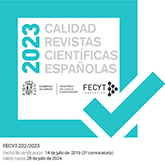El Atrium en las Vitas Sanctorum Patrum Emeretensium. ¿Una fórmula de la llamada arquitectura del poder?
DOI:
https://doi.org/10.3989/aespa.1994.v67.439Abstract
In this work we pretend to delimitate the meaning of the term atrium in Vitas Sanctorum Patrum Emeretensium. We believe that «atrium» is used by the brief treatise of Mérida with a very precise meaning that does not correspond with the vagueness fo what the architectural language usually expresses with this therm. Using this Font, we try to prove that the form and function of this building correspond to an architectural formula of power, in the Mérida of about the middle of the VIIth century. The comparison witn the Etymologies of Saint Isidore proves that the discourse is not exclusive of Mérida, but rather that atrium is considered in the Visigothic Hispania as a aulic architectural formula, adopted by the religious power.
Downloads
Download data is not yet available.
Downloads
Published
1994-12-30
How to Cite
Godoy Fernández, C., & Tuset Bertrán, F. (1994). El Atrium en las Vitas Sanctorum Patrum Emeretensium. ¿Una fórmula de la llamada arquitectura del poder?. Archivo Español De Arqueología, 67(169-170), 209–221. https://doi.org/10.3989/aespa.1994.v67.439
Issue
Section
Articles
License
Copyright (c) 2018 Consejo Superior de Investigaciones Científicas (CSIC)

This work is licensed under a Creative Commons Attribution 4.0 International License.
© CSIC. Manuscripts published in both the printed and online versions of this Journal are the property of Consejo Superior de Investigaciones Científicas, and quoting this source is a requirement for any partial or full reproduction.All contents of this electronic edition, except where otherwise noted, are distributed under a “Creative Commons Attribution 4.0 International” (CC BY 4.0) License. You may read here the basic information and the legal text of the license. The indication of the CC BY 4.0 License must be expressly stated in this way when necessary.
Self-archiving in repositories, personal webpages or similar, of any version other than the published by the Editor, is not allowed.














